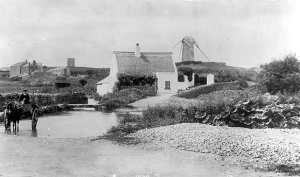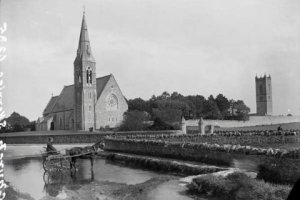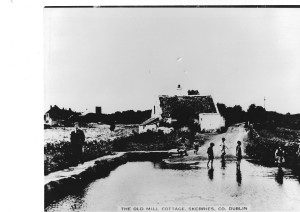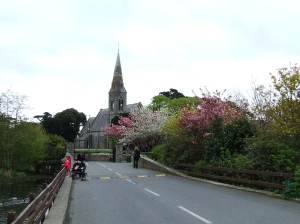The connection is in the name. Constable. He spent his life painting by the River Stour. He depicted tranquil rural scenes, scenes that remind us of some lost Eden, real or imagined. In the age of the dark, Satanic mills, he brought his viewers back to a time of simplicity, where a man might pause at a ford to let his horses drink—-a place where he could draw strength from the beauty around him. If there is drama, it is in the sky. Meteorologists praise the accuracy of his clouds. They claim that they can read the weather and compile an accurate report for the day on which he painted any given landscape. There could be a drop of rain there in the afternoon. I hope he gets the hay in safely. Others blame him for not engaging with the great issues of the day, politics, war, social injustice; the figures are too small, reflecting a lack of interest in his fellow man. Is that relevant? Has he not raised the spirits of many generations by the sheer beauty of his paintings. In our own age of anxiety and stress, is it not good that we can stand by Constable’s river and look at the trees, the mill, the soaring clouds and a man taking a break while his horses refresh themselves?
Skerries people love the image of The Mill Cottage, a trim white-washed building beside the ford. Perhaps your grandparents knew that man. Perhaps he was your grandfather. Perhaps he had a life that consisted of more than pausing, one day for a photographer, on his way back from the mill. Maybe his life was filled with drama and struggle, with wit and music and the laughter of children. Did his horse drink from the stream? It was a time before pesticides and chemical fertilisers. I drank that water despite dire warnings, but from much further upstream. You could lie at the edge on a small, gravelly margin, supporting yourself like a crocodile, your elbows sticking out to either side. There was a chalky, limey taste, with a suggestion of mud and weeds and God knows what else. I didn’t get liver fluke or brucellosis, bovine TB or potato blight. Some unkind souls have noted a touch of foot in mouth disease, but let’s move on.
Had Constable spent a holiday in Skerries, he might have gone for the reverse view, but he could have missed the pond or even the cottage. He would definitely have asked the driver not to pose so stiffly in the the middle of the pond. He would probably have postponed his painting for a century of two, until the trees had a chance to grow to picturesque proportions and the Mill Cottage had been built. [When was it built?]
I like to think that I feature in this photograph. I wasn’t as dilapidated as the cottage had become. Not yet. We weren’t posers or poseurs, as the posers say. We were serious fishermen going about some serious business. There were pinkeens in the shallows and under the limestone slab. I found a shilling in the water once. My brother caught a trout—with a shovel. My sister made mud-pies, on her way home from school. She and Ann Duff, stopped to perfect their art. ‘Oh here’s a really mucky one,’ she cried out in triumph. (She was very good at mud-pies.) An old woman carrying a bundle of sticks, took it as a reflection on her personal hygiene. A constable came to our house. He was a Guard, really, but I needed the pun. ”There has been a complaint’, he explained to my parents. ‘We got this letter.’ The letter contained inflammatory language and mention of solicitors. It looked as if my sister would do time. There was a tribunal of enquiry. ‘Ah,’ said the Guard, ‘take no notice of her. She’s as daft as a brush.’ He explained, apologetically, that he had to mention the matter. I would have brought her a canary, if she had gone ‘inside’. Nevertheless, mud-pie production fell off sharply after the incident.
There were three black huts in the field behind the cottage. We called it the Mill Field but it was once The Wireless Field. During World War I the British Navy installed a radio mast and wireless telegraphy equipment to talk to the ships in the Irish Sea. The huts were built of railway sleepers, if I recall correctly, and covered in tar. I thought that The Blackened Hands built them. I got into trouble for arriving home with tarry hands and tarry clothes, any time I went into the Mill Field. A school friend told me that his father burned the Blackened Hands out of those huts, but strangely, the huts were still there forty years later.
Joey Brannigan lived in the Mill Cottage for many years. He took part in that war, as did a fellow Skerries man, Gunner Welsh. They met at The Front, one driving a mule, laden with ammunition and the other coming back from a forward position. One said to the other: ‘I wouldn’t go up there, if I was you. They’re effin’ killin’ each other up there.’ Nobody ever put it better, although he didn’t say ‘effin’. In this centenary year there will be a tsunami of books, television documentaries, parades and ceremonies. When the captains and the few remaining kings, the learned historians and the military history nerds, have had their say, remember what that Skerries man said: ‘I wouldn’t go up there , if I was you. They’re effin’ killin’ each other up there.’ Happily they both survived.
There’s a much better road there now, with a bridge and a car park. We have gained a duck pond, but lost a cottage. The trees are taller. The children are better-dressed and probably, better fed. They don’t drink from the stream or catch pinkeens. What would Constable make of it? (My sister, by the way, is an exemplary citizen…with no criminal record.)






